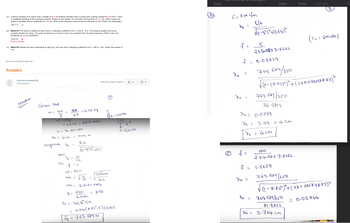
College Physics
11th Edition
ISBN: 9781305952300
Author: Raymond A. Serway, Chris Vuille
Publisher: Cengage Learning
expand_more
expand_more
format_list_bulleted
Concept explainers
Topic Video
Question
thumb_up100%
I provided a solution and provided a question with different number please solve

Transcribed Image Text:(a) A device consists of an object with a weight of 40.0 N hanging vertically from a spring with a spring constant of 250 N/m. There
is negligible damping of the oscillating system. Applied to the system is a harmonic driving force of 11.0 Hz, which causes the
object to oscillate with an amplitude of 4.00 cm. What is the maximum value of the driving force (in N)? (Enter the magnitude.)
769.11 N ✓
(b) What If? The device is altered so that there is a damping coefficient of b = 5.00 N s/m. The hanging weight and spring
constant remain the same. The same driving force as found in part (a) is applied with the same frequency. What is the new
amplitude (in cm) of oscillation?
6.523 cm. x
Enter a number.
(c) What If? Repeat the same calculation as part (b), only now with damping coefficient of b = 100 N s/m. (Enter the answer in
cm.)
Show transcribed image text
Answers
narendra answered this
1,701 answers
Solution:
Given That
m=
40
g
201 - من
2
= 2πT XII = 69.11 rad|s
x= no Sin wt
No = 4cm
amplitude Xo
Here
501
что =4.08 ку
9.8
= 0.04 m
folk
√(1-9) 7(269) ²
7
Fo=
q
f
6= 69-11
حبا
соп
O
con =
Was this answer helpful?
250×9.8
m
40
wn = 7.8262 radls
q=
69.11 = 8.83
7.8261
Xo (9²-1) k
Fo=769.689 N
k=250N/m
m
TS
= 0.04 (8.83²-1) (250)
5
F = Fosin t
0
View
Ⓒ
C= 5N-1/m
Xo =
Xo
f =
f
Xo =
f=
=
f:
Xo = 0.0399
Хо
Xo =
√(1-9²1²+(279)²
5
Xo = 4cm
Xo =
Zoom
2X408x7.8262
0.07829
769.689/250
√(1-(8.833²)² + (2x0.07829x8.83) ²
769.689/250
76.9813
3.99 = 4 Cm
Share Highlight
100
2x4.08 x 7.8262
1.5658
(cc = 2mwn)
769,689/250
(1-8.83²)² + (2x1.5658X8,833²
769689/250
81.7853
Xo = 3.764 cm
= 0.03764

Transcribed Image Text:(a) A device consists of an object with a weight of 25.0 N hanging vertically from a spring with a spring constant of 250 N/m. There is negligible damping of the oscillating system.
Applied to the system is a harmonic driving force of 13.0 Hz, which causes the object to oscillate with an amplitude of 4.00 cm. What is the maximum value of the driving force (in
N)? (Enter the magnitude.)
670.8
N
(b) What If? The device is altered so that there is a damping coefficient of b = 5.00 N. s/m. The hanging weight and spring constant remain the same. The same driving force as found
in part (a) is applied with the same frequency. What is the new amplitude (in cm) of oscillation?
cm
(c) What If? Repeat the same calculation as part (b), only now with a damping coefficient of b = 100 N s/m. (Enter the answer in cm.)
cm
Expert Solution
This question has been solved!
Explore an expertly crafted, step-by-step solution for a thorough understanding of key concepts.
This is a popular solution
Trending nowThis is a popular solution!
Step by stepSolved in 7 steps with 7 images

Knowledge Booster
Learn more about
Need a deep-dive on the concept behind this application? Look no further. Learn more about this topic, physics and related others by exploring similar questions and additional content below.Similar questions
- Can you please answer this question and all of the sub parts and show all of the steps to the solutionarrow_forwardCan you please answer number 4 and show all of the steps to the solutionsarrow_forwardWhy not draw the line on my graph by simply connecting two of the data points, for example the first and last ones?arrow_forward
- Can you please solve this question and all of the sub questions and show all of the stepsarrow_forward24h) Find the correct value of this question, only typingarrow_forwardI know this website says only to submit one question at a time but this word problem has 12 questions to answer. If you can only answer one at a time I guess we can start with #3. all help is greatly appreciated, please see the attachment. Thank you, Miguelarrow_forward
arrow_back_ios
SEE MORE QUESTIONS
arrow_forward_ios
Recommended textbooks for you
 College PhysicsPhysicsISBN:9781305952300Author:Raymond A. Serway, Chris VuillePublisher:Cengage Learning
College PhysicsPhysicsISBN:9781305952300Author:Raymond A. Serway, Chris VuillePublisher:Cengage Learning University Physics (14th Edition)PhysicsISBN:9780133969290Author:Hugh D. Young, Roger A. FreedmanPublisher:PEARSON
University Physics (14th Edition)PhysicsISBN:9780133969290Author:Hugh D. Young, Roger A. FreedmanPublisher:PEARSON Introduction To Quantum MechanicsPhysicsISBN:9781107189638Author:Griffiths, David J., Schroeter, Darrell F.Publisher:Cambridge University Press
Introduction To Quantum MechanicsPhysicsISBN:9781107189638Author:Griffiths, David J., Schroeter, Darrell F.Publisher:Cambridge University Press Physics for Scientists and EngineersPhysicsISBN:9781337553278Author:Raymond A. Serway, John W. JewettPublisher:Cengage Learning
Physics for Scientists and EngineersPhysicsISBN:9781337553278Author:Raymond A. Serway, John W. JewettPublisher:Cengage Learning Lecture- Tutorials for Introductory AstronomyPhysicsISBN:9780321820464Author:Edward E. Prather, Tim P. Slater, Jeff P. Adams, Gina BrissendenPublisher:Addison-Wesley
Lecture- Tutorials for Introductory AstronomyPhysicsISBN:9780321820464Author:Edward E. Prather, Tim P. Slater, Jeff P. Adams, Gina BrissendenPublisher:Addison-Wesley College Physics: A Strategic Approach (4th Editio...PhysicsISBN:9780134609034Author:Randall D. Knight (Professor Emeritus), Brian Jones, Stuart FieldPublisher:PEARSON
College Physics: A Strategic Approach (4th Editio...PhysicsISBN:9780134609034Author:Randall D. Knight (Professor Emeritus), Brian Jones, Stuart FieldPublisher:PEARSON

College Physics
Physics
ISBN:9781305952300
Author:Raymond A. Serway, Chris Vuille
Publisher:Cengage Learning

University Physics (14th Edition)
Physics
ISBN:9780133969290
Author:Hugh D. Young, Roger A. Freedman
Publisher:PEARSON

Introduction To Quantum Mechanics
Physics
ISBN:9781107189638
Author:Griffiths, David J., Schroeter, Darrell F.
Publisher:Cambridge University Press

Physics for Scientists and Engineers
Physics
ISBN:9781337553278
Author:Raymond A. Serway, John W. Jewett
Publisher:Cengage Learning

Lecture- Tutorials for Introductory Astronomy
Physics
ISBN:9780321820464
Author:Edward E. Prather, Tim P. Slater, Jeff P. Adams, Gina Brissenden
Publisher:Addison-Wesley

College Physics: A Strategic Approach (4th Editio...
Physics
ISBN:9780134609034
Author:Randall D. Knight (Professor Emeritus), Brian Jones, Stuart Field
Publisher:PEARSON